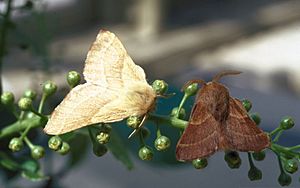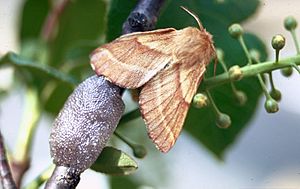Western tent caterpillar facts for kids
Quick facts for kids Western tent caterpillar |
|
|---|---|
 |
|
| larvae | |
 |
|
| Adult | |
| Scientific classification | |
| Genus: |
Malacosoma
|
| Species: |
californicum
|
| Synonyms | |
|
|
The western tent caterpillar (scientific name: Malacosoma californicum) is a type of moth. It belongs to the family Lasiocampidae. These caterpillars are known for building large, silky "tents."
You can find the western tent caterpillar in southern Canada, the western United States, and parts of northern Mexico. There are six different types, or subspecies, of this caterpillar. They like to live in groups, especially when they are young. They spend a lot of time together inside their silken tents.
These caterpillars have one generation each year. Adult moths appear in late summer to mate and lay eggs. They often choose the sunny side of a tree to lay their eggs. The eggs stay hidden over winter and hatch the next spring. Sometimes, their numbers grow very large. This is called an outbreak. During an outbreak, they can eat many leaves from trees. But don't worry, most trees grow their leaves back quickly!
Contents
What They Look Like
When a western tent caterpillar is fully grown, it is about 4 to 5 centimeters long. That's about the length of your finger! They can be black, grey, or white. They have a cool orange stripe running down their back. Each body part also has blue-white lines. Small hairs, called setae, stick out from their bodies.
The pupae (the stage before they become moths) are smaller, about 2 to 2.5 centimeters. They are reddish-brown to black. Pupae spin a white, silky cocoon. This cocoon is covered in white and yellow powder.
Adult moths have wings that spread out between 3.5 and 5 centimeters. They can be brown, yellow, tan, or grey. Their wings usually have two lines that are lighter or darker than the rest of the wing.
Life Cycle and Habits
What They Eat
Young western tent caterpillars, called larvae, eat leaves from many different plants. They are not picky eaters! However, what they prefer to eat depends on where they live. The female moth lays her eggs on the tree where her babies will eat. They often eat leaves from stone fruit trees. But they can also eat leaves from many other types of trees.
Adult moths do not eat at all. They only live for about 1 to 4 days.
How They Stay Warm
Western tent caterpillars are ectothermic. This means they can't make their own body heat. Their body temperature depends on the temperature around them. Caterpillars warm up by sitting in the sun. They also huddle together in close groups. This helps them raise their body temperature. Getting warmer helps them grow faster.
Their Behavior
When caterpillars are young, they live together in their silken tents. Living in groups helps them in many ways. It can scare away animals that want to eat them. It also helps them stay warm. And it helps them find food together.
As caterpillars get older and bigger, they need more food. So, they start to live alone. They leave their tents and find food by themselves.
Reproduction
Western tent moths mate in the middle of summer. Male moths will compete to find a female. Female moths can mate with several males. A female lays a band of eggs around a tree branch. One egg band can have hundreds of eggs!
Outbreaks
Sometimes, the number of western tent caterpillars grows very, very high. This is called an outbreak. Outbreaks happen in cycles, usually every 6 to 11 years. When there's a big outbreak, the caterpillars can eat many leaves from trees. But most trees grow their leaves back quickly. So, the damage to the trees is usually not too bad.
People might find large numbers of caterpillars annoying. But scientists say they don't really harm the forest. Trees can recover easily. It's best to try to control them before their numbers get too high.
Scientists don't fully understand why outbreaks happen. They think it's a mix of things like weather, animals that eat them (called predators), and even viruses. A special virus called NPV (Nuclear Polyhedrosis Virus) seems to play a big role. When there are many caterpillars, the virus spreads more easily. This can cause the caterpillar population to drop quickly.
Timing with Plants
Western tent caterpillars and their host plants are closely connected. The caterpillars' eggs usually hatch at the same time the tree buds open. This makes sure the young caterpillars have fresh leaves to eat right away.
However, caterpillars can hatch up to two weeks before or after the tree buds open. Scientists think that with climate change, this timing might get off. Caterpillars might start hatching earlier. But it seems this doesn't hurt the caterpillars much. They are good at surviving even if they don't get food right away.
Subspecies
- Malacosoma californicum ambisimile (Dyar, 1893)
- Malacosoma californicum californicum
- Malacosoma californicum fragile (Stretch, 1881)
- Malacosoma californicum lutescens (Neumoegen & Dyar, 1893)
- Malacosoma californicum pluvialis (Dyar, 1893)
- Malacosoma californicum recenseo Dyar, 1928


